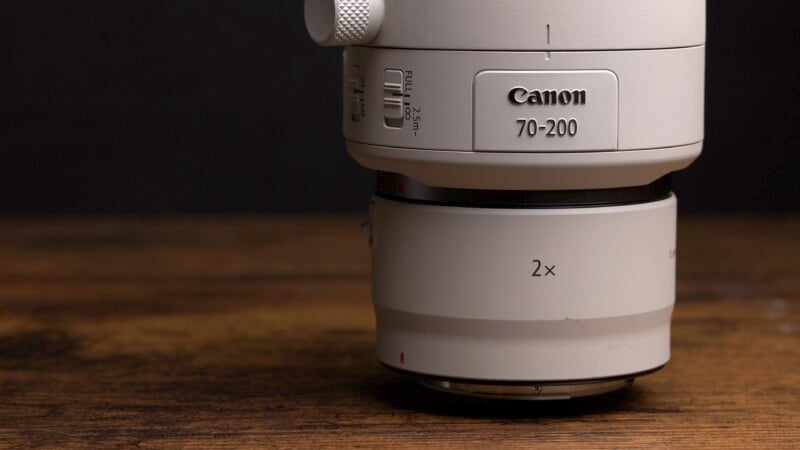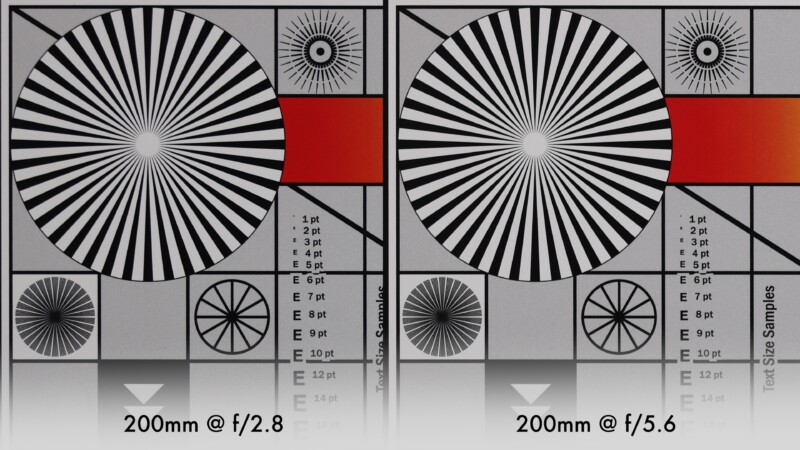I like the ultra-compact Canon RF 70-200mm f/2.8L lens very much. It’s easy to carry around in the camera bag. It’s very sharp and well-corrected. But the inability to attach a teleconverter is a huge strike against a fast 70-200mm lens and video shooters don’t like the shifting balance as you zoom the extendable lens elements.
Enter the new Canon RF 70-200mm f/2.8L IS USM Z lens. Now we have a new “Z” version which can take a teleconverter and promises to be hybrid-friendly with its internal zoom and option for a power zoom motor. But the $3,000 price is very high and I’m left asking: do the ends justify the desperate need for means to get this lens?
Canon RF 70-200mm f/2.8L Z Review: How It Feels
The design of this lens is a more traditional approach to the extendable version and has both a classic aperture ring and internal zoom. The balance stays fairly equal as you zoom in, and the weight is now a lovely 39.2 ounces (1.11kg). The aperture ring functions with only a smooth operation and there is an auto setting to control the aperture from the body, however, this aperture ring only functions in photo mode on the latest bodies like the R5 Mark II and R1. This is exactly the same as the 24-105mm f/2.8 Z lens and I assume there is some sort of logical engineering reason why this is, but I still hate it. I’ll probably control the aperture from the body anyway but you can dedicate the forward control ring to the aperture if you want to have a click-stop option.

Most notably, the outer dimensions are identical to the 24-105mm f2.8 Z lens. This does have benefits to the user who owns both and can switch seamlessly between the two lenses, relying on their muscle memory regardless. You can also get the new 70-200 in either black or white.

The filter thread is an easy-to-find 82mm diameter. Although this new lens is physically longer than the first version, they are roughly the same when the older lens is zoomed out so the space savings is more in the camera bag than it is in the hand. Weight is essentially the same too.

You get all the usual switches and controls for image stabilization and focus limiter, and you get a customizable button as well. The tripod collar foot can be removed but there are no click stops at the 90-degree mark. Unfortunately, there are no cuts for Arca Swiss heads in the tripod foot. Like all “L” lenses, the lens should be incredibly rugged.


Canon RF 70-200mm f/2.8L Z Review: How It Shoots
I tested flare and as expected, Canon has very advanced coatings to limit issues. There is no major loss of contrast and minimal ghosting when pointing the lens at bright backgrounds. I also wanted to see if LoCA was a problem but the lens is very well corrected. LoCA will cause color shifts in the out-of-focus areas, but the 70-200mm only had the slightest color fringing to manage.



Bokeh is very smooth with gentle transitions of focus throughout the depth of the image. However, I was surprised to see onion rings in the specular highlights and there is a slight soap bubble effect. The backgrounds look somewhat harsh and they probably would look smoother if the bokeh was cleaner.


Sharpness is excellent overall with tons of detail at f/2.8 no matter where you zoom the lens. Stopping down really has no effect on contrast or detail so this lens is absolutely optimized for shooting wide open. Even the corners held up well and were noticeably better than the first RF 70-200mm. There is a little softness at f/2.8 but the corners sharpen up nicely with the aperture closed a bit.


As a close-up lens, the new 70-200mm Z has some versatility with its best macro at the 200mm range. You can achieve 0.3x magnification at 0.68 meters which is fine for the occasional shot up close.

Canon RF 70-200mm f/2.8L Z Review: This Lens is for Video
Video work is where this lens really shines and the emphasis on cinema projects is clear to see. First, this lens has almost no breathing which is a shift in the field of view as the lens is focused. This makes the 70-200mm Z ideal for pulling focus during a scene without any distracting shifts.

Even more impressive is that this lens is almost completely parfocal. This means that you can manually focus at 200mm, for example, and zoom the lens to 70mm without incurring a shift in focus. Doing a slow push-in with the power zoom attachment while on a subject will maintain the focus nicely whether using manual or automatic focusing. Therefore, Canon has given us a lens that is still very portable and lightweight with excellent optical performance. However, it is also clear that you are paying a premium for the more cinematic video-based improvements to the lens, whether you are going to shoot video or not.

Choosing Between a Rock and a Hard Place
With the new 70-200mm f/2.8L IS USM Z lens being priced at $3,000, it is well above its competitors from other brands like the Sony G-Master or Nikon 70-200mm lenses. However, the original RF 70-200mm is a little lower in price now at $2,500. I would recommend this as a more affordable choice for photographers specifically. Well, I normally would, except that I found myself using the 2x teleconverter all the time while testing this latest lens and loving the results. If the original could take teleconverter as well it would be a no-brainer. Sadly, you’ll have to decide if the option for extra reach is worth the inflated price range for you. Regardless, you’ll get a fantastic lens no matter which way you go.

Are There Alternatives?
As mentioned, the RF 70-200mm f/2.8L is your only modern choice. You could go with an EF 70-200mm with an adapter but you’ll be dealing with more bulk than you may like. I would normally suggest the Tamron and Sigma alternatives, however, Canon still hasn’t opened up its full-frame mounts to third-party manufacturers.
Should You Buy It?
Maybe. If you are really into videography, then this is the lens for you. Photographers who want the flexibility of a teleconverter will also have to pony up the extra cash.
